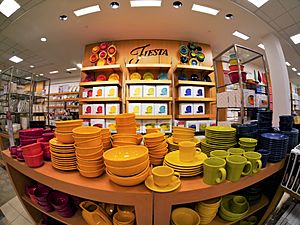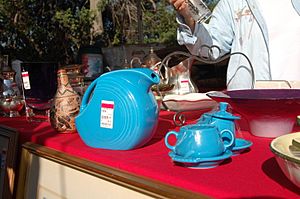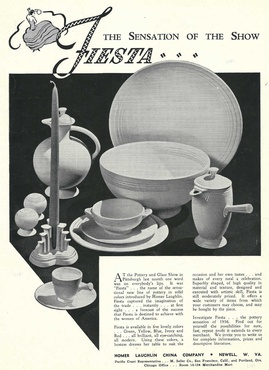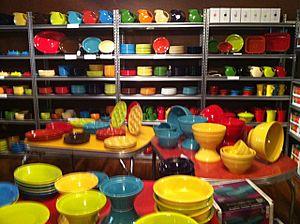Fiesta (dinnerware) facts for kids
Fiesta is a famous type of dinnerware (plates, bowls, cups) known for its bright, solid colors. It's made from ceramics and has a shiny glaze. The Fiesta Tableware Company in West Virginia has been making it since 1936. They stopped for a while between 1973 and 1985, but then brought it back! Fiesta is famous for its cool, modern look, which is called Art Deco style.
The company used to be called the Homer Laughlin China Company. In 2020, they changed their name to the Fiesta Tableware Company. They kept making the popular Fiesta line and kept their factories in West Virginia.
A designer named Frederick Hurten Rhead created the original shapes and colors for Fiesta. He worked for the company until 1942. Later, in 1984, Jonathan O. Parry became the art director and added new shapes. Early Fiesta pieces were a type of pottery. After 1986, they started using a stronger material called vitreous china. This made the dishes more durable, even for restaurants.
From the very beginning, you could buy Fiesta in sets or as "open stock." This meant you could pick and choose individual pieces. You could mix and match different colors to create your own unique collection! Fiesta became very popular because of its fun colors, cool design, and affordable price. In 2002, The New York Times even called it "the most collected brand of china in the United States."
Contents
Why Fiesta Became So Popular
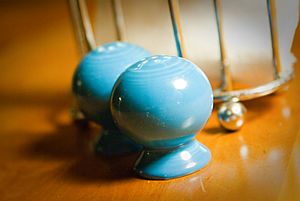
Fiesta was first shown to the public in January 1936 at an exhibit in Pittsburgh, Pennsylvania. Before Fiesta, most dinnerware in the US had detailed patterns. Fiesta was different because it came in solid colors. While some smaller companies made solid-colored pottery, Fiesta was the first to be widely promoted across the country.
In the 1930s, most dinnerware sets were all decorated the same way. Fiesta changed this with its bold, solid colors and the idea that you could mix and match pieces. This was a totally new idea for many people! The shapes and surfaces of Fiesta dishes showed the influence of Art Deco design, which was very modern at the time.
When it first came out, the Fiesta line had about 37 different pieces. These included plates, bowls, cups, and even things like candle holders and vases. You could buy basic sets for four, six, or eight people. But the company really encouraged people to buy individual pieces. This way, everyone could create their own unique table settings.
A brochure from the company said:
"COLOR! that's the trend today ... It gives the hostess the opportunity to create her own table effects ... Plates of one color, Cream Soups of another, contrasting Cups and Saucers ... it's FUN to set a table with Fiesta!"
The company quickly added more items to the Fiesta line. At its biggest, the Fiesta collection had about 64 different items. These included flower vases, divided plates, and large serving platters.
During World War II, factories focused on making things for the war effort. This meant less non-war production, and public demand for dinnerware also decreased. From 1942, the number of Fiesta items began to shrink. By 1946, about a third of the items had been stopped. However, sales of the main place-setting pieces remained strong. Fiesta's popularity peaked around 1948. Its bright colors, strong build, and cool Art Deco designs made it a big hit. It became a popular item for middle-class homes in the late 1930s and early 1940s. Even today, old Fiesta pieces are very popular with collectors and are sold online and at antique shops.
Fiesta Colors Through the Years (1936–1969)
The Fiesta Tableware Company still owns the original designs. The shapes of the original Fiesta pieces stayed mostly the same from 1936 to 1969. However, the company often changed the colors to match new home decorating trends. The original glazes were smooth and glossy, but not overly shiny.
When Fiesta first launched in 1936, it came in five colors:
- Red (an orange-red)
- Blue (a cobalt blue)
- Green (a light green)
- Yellow (a deep golden yellow)
- Old Ivory (a yellowish cream)
In 1938, a sixth color was added:
- Turquoise (a robin's egg blue)
These colors, except for the Red, stayed in production until about 1950. The original Red was stopped before 1944.
After World War II, in the 1950s, home decorating styles changed again. The company decided to stop making some of the original colors. They replaced them with four new, modern colors:
- Rose (a dark brownish-pink)
- Gray (a medium gray)
- Forest (a dark green)
- Chartreuse (a bright yellowish-green)
So, the company still offered six colors, with Yellow and Turquoise remaining from the earlier collection.
Sales of Fiesta continued to slow down in the 1950s. But in 1959, the US government allowed the use of uranium again. This meant the company could bring back the original bright orange-red color! They stopped the four new colors from the 1950s. The new color collection for 1959 included the re-introduced Red, the original Yellow, Turquoise, and a new bright green. This new green is often called "medium green" by collectors.
This final group of four colors was made until 1969. Because overall sales had dropped, this "medium green" is harder to find today. Yellow and Turquoise were made continuously for a long time, and Red was also available for many years. So, these colors are more common for collectors. The "medium green" was only made for ten years when sales were lower, making it quite rare and sometimes very expensive for collectors.
Understanding Radioactive Glazes
The bright red Fiesta dishes from the early years (and other red pottery from that time) contain a tiny amount of uranium oxide in their glaze. This is what gave them their unique orange-red color.
During World War II, the US government needed uranium for the Manhattan Project (which developed the atom bomb). They took control of uranium supplies, so Homer Laughlin stopped making Fiesta red in 1944. In 1959, after the United States Atomic Energy Commission eased its rules, the company brought back Fiesta red. This time, they used depleted uranium.
It's important to know that red isn't the only color of old ceramic glaze that can be radioactive; some ivory pieces also show detectable levels. The amount of radioactivity in vintage Fiesta has been studied and information is available online.
The U.S. Environmental Protection Agency advises people not to use radioactive glazed ceramics for food or drinks. Others suggest not using them for food storage, especially with acidic foods. This is because tiny amounts of uranium or other heavy metals (which are sometimes in colored glazes) could potentially get into the food.
Changes and Discontinuation (1969–1973)
By 1969, home decorating styles had changed once more. The company tried to update Fiesta's look. They changed the handles on cups, the shapes of bowls, and the knobs on covers to make them more modern. The colors were also updated. They offered only three colors for most pieces and one color for the main serving pieces.
The red glaze was still available but was renamed Mango Red. Yellow, Turquoise, and Medium Green were replaced by two new colors: Turf Green (which looked like the popular "Avocado" color) and Antique Gold (a brownish-yellow like "Harvest Gold"). The line was renamed "Fiesta Ironstone." However, these changes didn't make Fiesta popular again. In January 1973, the company stopped making the Fiesta line.
Other Dinnerware Using Fiesta Shapes
Sometimes, manufacturers use the same dish shapes but add different designs or names. Throughout its original run (1936–1973), Fiesta shapes were often decorated with patterns and sold under other names. For example, "Fiesta Casuals" had floral designs. One version had yellow and brown flowers with solid yellow Fiesta pieces. Another had turquoise and brown flowers with solid turquoise Fiesta items.
In the late 1960s, Fiesta shapes were glazed in a dark brown. Flat pieces had a "Mediterranean-style" black design. This line was called "Amberstone" and was sold in a supermarket promotion. Later, these shapes were glazed in Antique Gold with a different pattern and called "Casualstone."
Collectors and the Resale Market
In the 1970s, people started to really appreciate Art Deco designs from the 1920s and 1930s. Also, many baby boomers were setting up their own homes. This made Fiesta popular again! Soon after Fiesta was stopped in 1973, collectors began buying pieces from second-hand shops and garage sales. They also found pieces at local auctions.
Because so many people wanted Fiesta, its prices went way up. By the late 1970s and into the 1980s, some Fiesta items that once cost pennies were selling for hundreds of dollars. By the mid-1980s, prices climbed even higher. Some very rare pieces and colors were being traded for thousands of dollars!
Modern Fiesta (Since 1986)
The Homer Laughlin China Company noticed how popular old Fiesta was becoming. So, after 13 years, they brought Fiesta back in 1986 to celebrate its 50th anniversary! At first, they used the same type of clay as the original Fiesta. But then they switched to a stronger, fully vitrified clay. This made the dishes more durable, so they could be sold to restaurants too.
Because of this new clay, many original shapes had to be redesigned. The new pieces look similar to the old ones, but they are slightly smaller. New shapes were also added to the line.
In 1986, the company offered five colors for the new Fiesta:
- Rose (pink)
- Black
- Cobalt (dark navy blue)
- White (bright white)
- Apricot (pale pinkish-tan)
The new Fiesta has a very smooth, hard, and glossy glaze, much shinier than the original. Since its return, new Fiesta has remained very popular. It has also made more people interested in collecting both old and new Fiesta pieces. Many collectors buy both vintage items and new ones from stores. The company has kept interest high by stopping some colors and introducing new ones. This makes collecting Fiesta an ongoing adventure!
The Homer Laughlin China Company has made new Fiesta in a total of 39 different colors. None of these colors exactly match the 13 colors of the original vintage Fiesta.
New Fiesta Colors (Examples)
Here are some of the new colors introduced since 1986:
- Yellow (pale custard) (1987–2002)
- Turquoise (more greenish than vintage) (1988–)
- Periwinkle (slightly lavender-blue) (1989–2006)
- Sea Mist (pale mint green) (1991–2005)
- Lilac (soft purple) (1993–1995)
- Persimmon (pinkish-orange) (1995–2008)
- Sapphire (medium bright blue) (1996–1997, exclusive to Bloomingdale's)
- Chartreuse (brighter and greener than vintage) (1997–1999)
- Sunflower (bright yellow) (2001–)
- Plum (dark purple) (2002–2016)
- Shamrock (bright deep green) (2002–2021)
- Tangerine (bright orange) (2003–2018)
- Scarlet (deep true red) (2004–)
- Lapis (denim blue) (2013–)
- Poppy (bright reddish-orange) (2014–)
- Slate (charcoal gray) (2015–)
- Daffodil (vibrant golden yellow) (2017–)
- Mulberry (deep purple) (2018–)
- Meadow (deep mint green) (2019–)
- Butterscotch (orange yellow) (2020–)
- Twilight (deep cobalt blue) (2021–)
- Peony (blush pink) (2022-)
Special Edition Colors
Since 1986, some Fiesta colors have been available for only a short time. Lilac, Chartreuse, and Juniper were each sold for just two years. Sapphire was a special color sold only at Bloomingdale's stores for two years. In 2008, Homer Laughlin released a limited-edition color called Chocolate.
In 1997, 500 special Raspberry-colored bowls were made. This was to celebrate the production of the 500 millionth piece of Fiesta dinnerware! For Fiesta's 75th anniversary in 2011, Homer Laughlin announced a special color called Marigold. They also started making special anniversary items each year, like baking bowls and a serving platter.
Fiesta's importance was recognized in 1988 when it was featured in a design exhibit at the Cooper Hewitt, Smithsonian Design Museum in New York City.
Square Fiesta Dinnerware
In 2009, a new line of square-shaped Fiesta dinnerware was introduced. You can find square dinner plates, salad plates, bowls, and mugs. Even though they are square, they still have the classic Fiesta look with the brand's famous rings.
In October 2016, the company announced they would stop making the square bowl and square mug.
Fiesta in Pop Culture
The play American Fiesta is about a character who is very passionate about collecting old Fiesta dinnerware.


